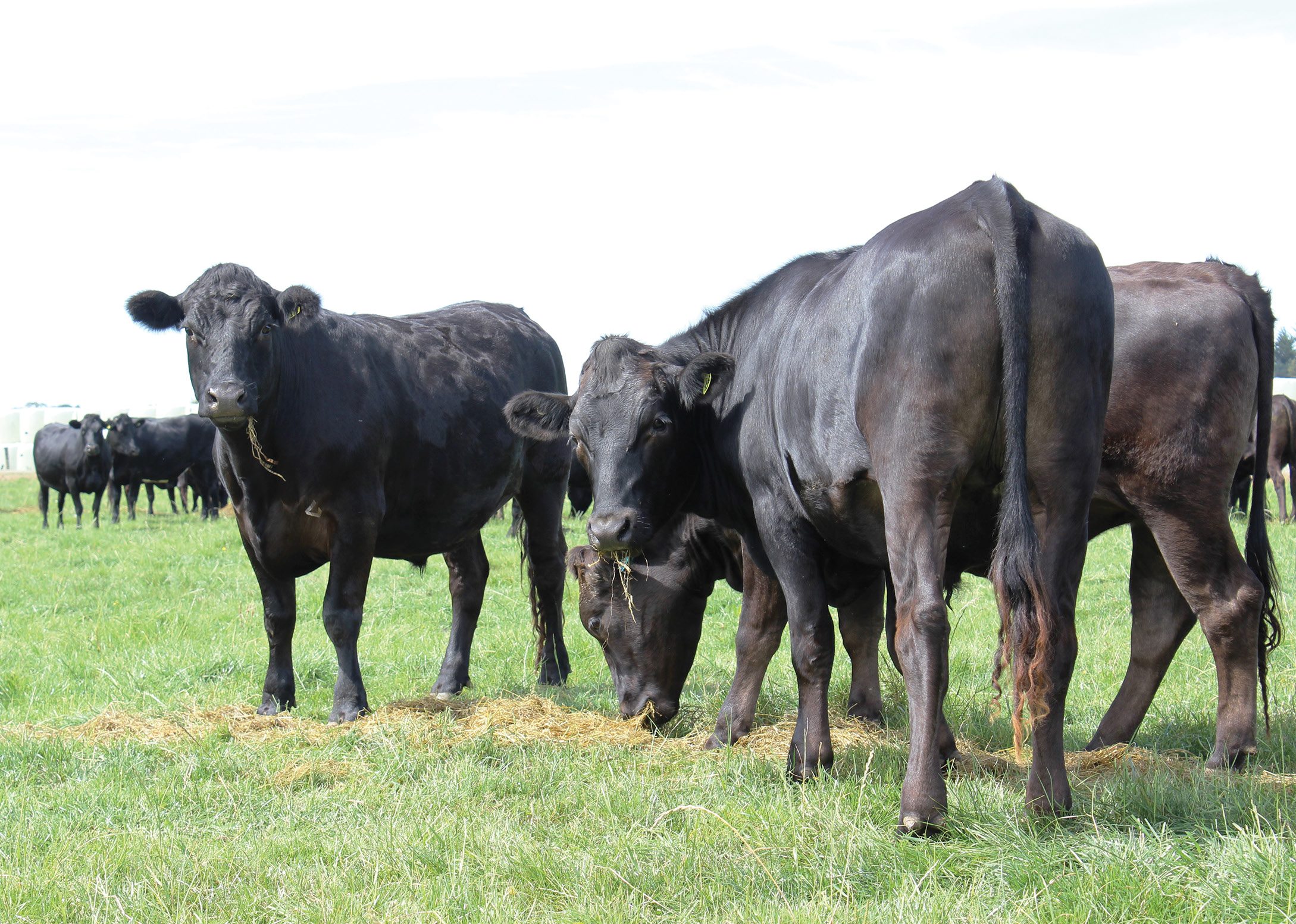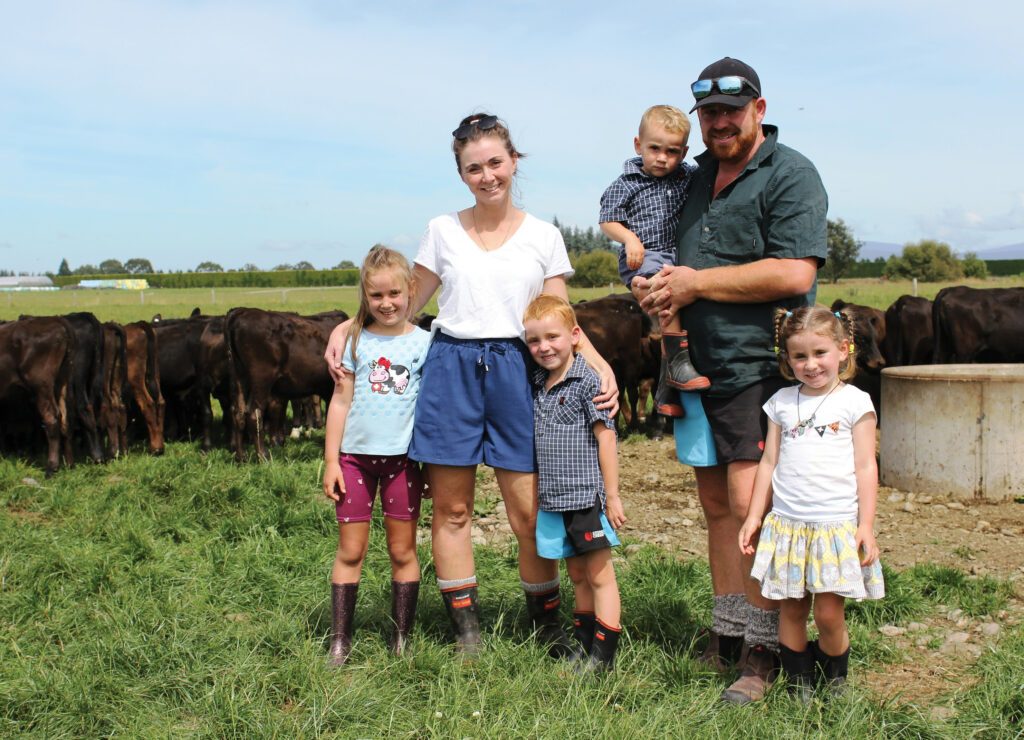Wagyu puts a twist on dairy beef

Reducing the number of bobby calves is part of the aim of NZ Wagyu’s
operations, plus there’s the extra income. Story and photos by Karen Trebilcock.
New Zealand dairy farmers are increasingly becoming part of a high-end beef trade.
NZ Wagyu contracts will see 28,000 Wagyu-Friesian cross calves born this spring, doubling the number of the company’s cattle in the country.
Barn-raised after 18 months on grass, the end product is marketed as Black Origin Wagyu and goes not only to Japan where Wagyu is a prized meat but China, South- East Asia and the Middle East.
It’s also on the menu at some of the best NZ restaurants.

Southland dairy farmer Scotty Cochrane, NZ Wagyu’s head of production, says the aim is to lower the number of bobby calves and to increase the payments the country gets for its beef exports.
“There is a place for everything – high-end, quality beef plus commercial beef run on hill country but at the moment we can’t fill demand.
“We’re producing a high quality meat that everyone can enjoy and as well the animal has had an extended life, and a good quality of life.”
Scotty has been in and around the dairy industry for 20 years and with his wife Jeannie and her parents in 2014 bought a dairy farm in Eastern Bush, Western Southland, milking 320 cows, as well as running an 800-hectare dry stock farm near Tuatapere, 18km away.
This is their first season running the Oreti Plains family farm, the third generation on it. It also marks a century of the family ownership.
The dry stock farm was run as dairy support and traded beef cattle and lambs, and it was through it Scotty was approached by NZ Wagyu director Arato Tsujino from Kobe, Japan.
Intrigued by their fair-trade values, Scotty could see working with NZ Wagyu was going to align well with his personal values.
They started by grazing 100 Wagyu cattle and now there are 2000 there, including a pure-bred breeding herd, and Scotty spends more time off farm than on it as the company’s head of production.
“It’s a very enjoyable change of pace. I’m talking to farmers all around the country and looking after NZ Wagyu farms in Hawke’s Bay, Canterbury and in Southland.
“It gets me up each morning.”
NZ Wagyu is in control every step of the beef production.
Dairy farmers use NZ Wagyu semen in their F12 or better cows and last spring were paid $180 for a five-to-10 day old Wagyu cross calf and $530 for a 100kg weaned calf plus $2/kg liveweight over 100kg, whether they were heifers or bulls.
Costs for debudding, castration and vaccination were covered by NZ Wagyu with payment 14 days after pickup on invoice. Further contracts are available for farmers rearing the weaned calves to 400kg and 520kg liveweight when the animals go into barns and are grain fed.
NZ Wagyu differs from First Light Wagyu as it only wants calves from F12 or better dairy cows and while First Light beef is grass-fed, NZ Wagyu finishes its cattle on grain.
“We’re providing a way for dairy farmers to stop having bobby calves. We’re producing high quality beef from what previously farmers may have got $20 for,” Scotty says.
“On our own dairy farm, stock sales have gone from being 11% of income to twice that so for us, changing has not only been an ethical decision but also a financial one.”
To protect their breed, Japan has imposed a ban on the live export of the cattle and genetic material so NZ Wagyu has imported embryos from the United States and Australia and is focusing on breeding quiet animals that can integrate the hardiness of Friesians.
“We’re also concentrating on shortening their gestation period which is about five to 10 days longer than a typical Friesian.
“They have low birth weights and are known for their ease of calving which is another advantage for the dairy industry.”
On their own 320 dairy cattle, they used sexed semen on the top cows for three weeks with everything else going to Wagyu. Wagyu bulls are used to clean up once AI ends.
Last spring they raised 65 Friesian heifer calves and 230 Wagyu heifers and steers.
Jeannie, as much as their three children, Mac (6), Charlie (5) and Ted (2) allow, assists with calf rearing and says there is no difference in getting the Friesian calves to feed than the Wagyu.
“They’re just as competitive as the Friesians,” she says. “They all go outside on grass together when we get a good 10-day forecast, which can be a bit trying in Southland.”
The couple are careful to make sure all their cows have been vaccinated for Rotavirus and they have a Brix tester at the dairy to make sure the calves get the best colostrum.
“When I started dairying 20 years ago we left the calves on their mums as long as possible so they got enough colostrum,” Scotty says.
“Now we don’t leave it up to chance. We’ll pick up calves up to five times a day, depending on the weather and how many calves are getting born, and we make sure every calf gets two feeds of two litres of the highest quality colostrum we’ve got.
“We’re careful how we store it and the high quality colostrum is in its own vat with a stirrer.”
Calves that refuse to suck are tube-fed for a maximum of two feeds but after that Jeannie says if they don’t suck for the next feed they’re given a few hours before trying again.
“That’s how we get a bullet-proof animal,” Scotty says. “Two feeds of the best colostrum.”
They’ve also found focusing on feeding from weaning to the first winter when they go on brassicas in Southland sets the animals up well.
“They’re getting up to 2kg of grain a day plus as much grass as they can eat at the moment. If the grass isn’t there they’re getting balage as well.
“Post weaning I think is really key to growing a good animal and if we look after them well then the following year, when they’re 18 months, they’ll be up to 520kg and ready for barn entry.”
When other breeds of beef will be sent to the works, NZ Wagyu animals go into barns where they are fed solely on a grain and mineral mix that Scotty says is as secret as the Colonel’s blend of 11 herbs and spices.
“It’s all New Zealand-grown – we’re not importing feed but I’m not saying anything more than that.
“The grain and precise management of using different mixes at different stages, as well as how happy you can make the cattle, gives the meat the Wagyu flavour, scent and marbling.
“And we make sure they have the best water. That’s really important too.”
Their stay in the barns is between 200 and 420 days. Although raising cattle in barns has not been the NZ way, Scotty is ready for the criticism.
“At the age other beef cattle are getting killed, ours are going into comfortable barns to be fed their favourite grain. There is no stress. They’re not getting cold and they’re not out in the rain or the sun.
“Instead they get daily interaction such as pats and scratches, which makes the Wagyu feel safe and happy.
“We’re learning how Japanese traditionally treat animals with respect and care. Simply, we’re trying to provide an equally comfortable life to that of a human being. It’s an eye-opening experience.
“It’s a change of mindset. It’s a different concept for Kiwis for raising beef.”
The barns are well ventilated with composting floors and no stalls. Animals are in groups of 80 to 100 and kept in age groups. Each animal has eight square metres or more.
“The composting barns are really warm – it’s like having an electric blanket under their feet. And there’s no smell and the cattle are clean. In a normal barn, or even out in the paddock there is always muck on their coats. It doesn’t happen in a composting barn.”
NZ Wagyu uses Vetlife throughout the country and plans are in place for each animal to have its own health passport tracked from birth to plate.
With barns already in Hawke’s Bay and Canterbury, the first one is being built in Southland at Scotty and Jeannie’s family farm on the Oreti Plains.
“It’s 8000 sqare metres and we’re going to add a few extras to it if we can. I really want to capture the methane so we can use the energy from it.
“It’s also going to be automated for feed, water and temperature control.”
And the regional council so far has given it the thumbs up.
And yes, Scotty and Jeannie do have a freezer with Wagyu beef in it.
“We probably don’t eat as much beef now but it’s better quality beef. And it’s healthier.
“It’s hard to go back once you’ve tried Wagyu.”




